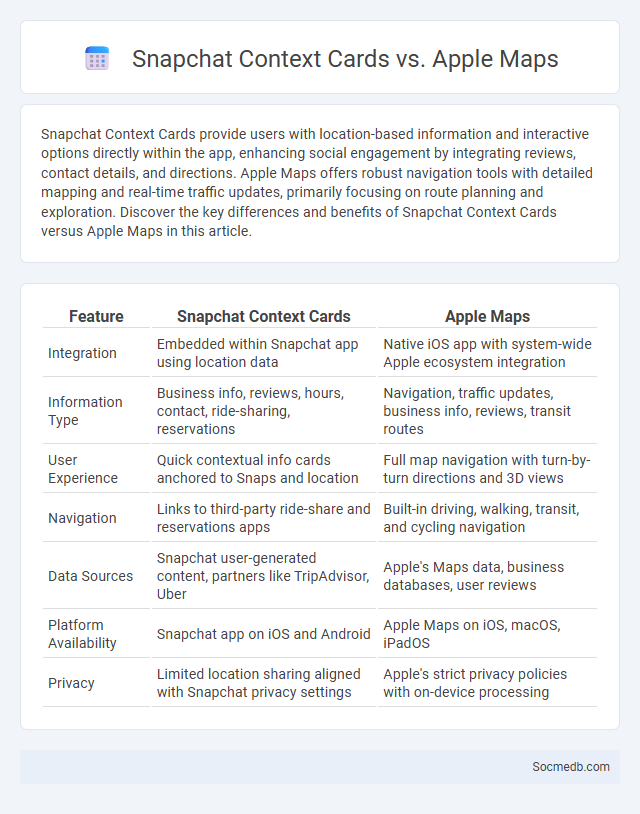
Photo illustration: Snapchat Context Cards vs Apple Maps
Snapchat Context Cards provide users with location-based information and interactive options directly within the app, enhancing social engagement by integrating reviews, contact details, and directions. Apple Maps offers robust navigation tools with detailed mapping and real-time traffic updates, primarily focusing on route planning and exploration. Discover the key differences and benefits of Snapchat Context Cards versus Apple Maps in this article.
Table of Comparison
| Feature | Snapchat Context Cards | Apple Maps |
|---|---|---|
| Integration | Embedded within Snapchat app using location data | Native iOS app with system-wide Apple ecosystem integration |
| Information Type | Business info, reviews, hours, contact, ride-sharing, reservations | Navigation, traffic updates, business info, reviews, transit routes |
| User Experience | Quick contextual info cards anchored to Snaps and location | Full map navigation with turn-by-turn directions and 3D views |
| Navigation | Links to third-party ride-share and reservations apps | Built-in driving, walking, transit, and cycling navigation |
| Data Sources | Snapchat user-generated content, partners like TripAdvisor, Uber | Apple's Maps data, business databases, user reviews |
| Platform Availability | Snapchat app on iOS and Android | Apple Maps on iOS, macOS, iPadOS |
| Privacy | Limited location sharing aligned with Snapchat privacy settings | Apple's strict privacy policies with on-device processing |
Introduction to Context Cards and Map Integrations
Social media platforms enhance user engagement through Context Cards, providing rich information previews that deepen content understanding before interaction. Map integrations allow you to visualize locations directly within posts, seamlessly connecting digital content with real-world places for improved navigation and relevance. These features optimize user experience by delivering contextual awareness and geographic insights that enrich social media interactions.
Overview of Snapchat Context Cards
Snapchat Context Cards provide users with detailed information about locations and events linked to Snaps, enhancing real-time engagement through integrated third-party reviews, maps, and Uber ride options. These cards incorporate data from partners like TripAdvisor, Foursquare, and OpenTable to deliver relevant content such as business hours, contact details, and user ratings. By seamlessly embedding contextual insights within the Snapchat interface, Context Cards elevate user interaction and decision-making on the platform.
Overview of Apple Maps Features
Apple Maps offers precise navigation, real-time traffic updates, and detailed 3D city views to enhance your social media location sharing and check-ins. You can explore curated guides, discover nearby places, and get seamless integration with Siri for voice-controlled directions. The app's privacy-focused design ensures your location data remains secure while improving your overall social media experience.
How Context Cards Enhance User Experience
Context Cards enhance your social media experience by providing relevant information instantly, eliminating the need to leave the platform. These interactive overlays offer detailed insights about posts, profiles, or events, improving engagement and decision-making. Access to enriched content through Context Cards makes navigation intuitive and interactions more meaningful, elevating overall user satisfaction.
Data Sources: Snapchat vs Apple Maps vs Context Cards
Snapchat leverages user-generated content and real-time location data to deliver personalized social experiences, while Apple Maps primarily relies on aggregated GPS data, satellite imagery, and authoritative business information for navigation and local search accuracy. Context Cards enhance Apple Maps by integrating third-party reviews, photos, and contact details, enriching your understanding of places directly within the app. Your choice between these platforms depends on whether you prioritize social interaction with dynamic data or comprehensive navigation supported by contextual insights.
Real-Time Information and Interactivity
Social media platforms deliver real-time information by enabling users to share updates instantly across global networks, facilitating immediate awareness of events as they unfold. Interactive features such as live streaming, polls, and comment sections enhance user engagement, allowing audiences to participate actively in conversations and influence content dynamics. This immediacy combined with interactivity drives rapid information dissemination and fosters dynamic community building.
Integration with Third-Party Apps and Services
Social media platforms enhance user experience by integrating seamlessly with third-party apps and services such as Spotify, Google Maps, and Shopify, enabling features like music sharing, location tagging, and e-commerce transactions directly within the social interface. APIs and OAuth protocols facilitate secure connections between social media accounts and external applications, ensuring data privacy while allowing personalized content and streamlined workflows. These integrations drive increased user engagement, expand platform functionality, and support cross-platform marketing campaigns for businesses.
Privacy and Data Security Comparison
Social media platforms vary significantly in their approaches to privacy and data security, with leading networks implementing end-to-end encryption, multi-factor authentication, and strict data access controls to protect user information. Facebook and Instagram face ongoing scrutiny for data-sharing practices and targeted advertising, while platforms like Signal and Telegram prioritize user anonymity and minimal data retention. Users should carefully evaluate privacy policies and security features to safeguard personal data amid increasing cyber threats and regulatory scrutiny.
User Interface and Ease of Navigation
Social media platforms prioritize user interface design by incorporating intuitive layouts, clear icons, and streamlined menus to enhance ease of navigation. Features like customizable dashboards and predictive search functions allow users to quickly access content and interact seamlessly with profiles, messaging, and notifications. Effective UI/UX strategies reduce user effort, increase engagement, and improve overall satisfaction across platforms like Facebook, Instagram, and Twitter.
Which Platform Offers the Best Contextual Mapping?
TikTok offers the best contextual mapping for social media due to its advanced AI algorithms that analyze user behavior and content interactions in real time. Instagram leverages image recognition and engagement patterns to deliver highly relevant content tailored to user interests. Facebook uses extensive data from user connections and activities to create detailed social graphs that enhance contextual relevance in its news feed.
 socmedb.com
socmedb.com